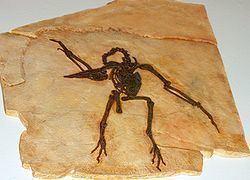Phylum Chordata | Class Aves Rank Order | |
 | ||
Family †LithornithidaeHoude, 1988 Similar Lithornis, Pseudocrypturus, Gastornithidae, Ichthyornithiformes, Hesperornithes | ||
Lithornithidae top 7 facts
Lithornithidae is an extinct, possibly paraphyletic (but see below) clade of early paleognath birds. They are known from fossils dating to the Upper Paleocene through the Middle Eocene of North America and Europe, with possible Late Cretaceous representatives. All are extinct today; the youngest specimen is the currently unnamed SGPIMH MEV1 specimen from the mid-Eocene Messel Pit site.
Contents
Lithornithids had long, slender, bills for probing. They closely resembled modern tinamous. They possessed a rhynchokinetic skull with relatively unfused cranial bones, a weakly fused pygostyle and a splenial. The unguals were more curved than in tinamous and probably allowed better perching in trees.
The order Lithornithiformes was erected by Dr. Peter Houde in 1988. Initially, only three genera (Lithornis, Paracathartes, and Pseudocrypturus) and eight named species were included. Promusophaga (Harrisson & Walker, 1977) originally considered a stem-turaco, is considered synonimous with Lithornis vulturinus. Fissuravis may also belong to the clade, and several unnamed remains are known.
Taxonomy
Lithornithiformes Houde 1988
Several studies have shown conflicting status on the monophyly of the group. Some studies recover them as a paraphyletic assemblage leading to modern paleognaths, but more recent examinations group them in a single, natural group basal to the rest of Palaeognathae. Of issue is Paracathartes, which differs radically from other lithornithids and has been suggested to more closely related to extant paleognaths, though it is recently recovered as a derived lithornithid.
Lithornis itself may be paraphyletic in relation to Paracathartes and Pseudocrypturus.
Flight
Unlike modern paleognaths, lithornithids were generally decent flyers. Lithornis, Pseudocrypturus and Fissuravis all possess well developed keels, pectoral girdle elements and proportionally large wings, allowing for soaring flight akin to that of birds such as modern vultures and storks. By contrast, however, Paracathartes had shorter and more robust wing elements and a deeper keel, relating to a flight style more akin to that of modern gamefowl and tinamous, and was possibly far more terrestrial.
Unlike neognath birds, lithornithids had small pygostyles, and probably no tails. This may not have impaired their flight, however, since prehistoric birds like enantiornithes also generally had no tails.
Eggs
Several egg fossils have been attributed to lithornithid birds. Both Lithornis and Paracathartes have entire nests assigned to them. Their eggshells are, perhaps unsurprisingly, noted as being "ratite-like".
